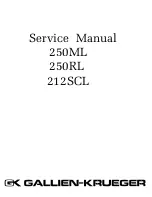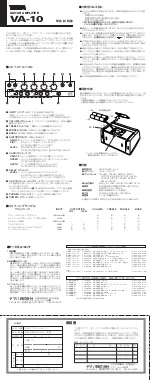
www.arrl.org
QST
February 2023 45
Table 3
Xiegu XPA125B Resistive Load and Loss Testing
VS WR/Impedance
160 M 80 M 40 M 20 M 10 M 6M
10:1/5 Ω
Loss (%)
66%
28%
.20%
20%
.20%
.28%
VSWR
2.2:1 1.6:1 1.6:1 1.4:1 1.2:1 1.5:1
8:1/6.25 Ω
Loss (%)
48%
17%
9%
9%
18%
22%
VSWR
3.9:1 1.8:1 1.6:1 1.6:1 1.4:1 1.5:1
4:1/12.5 Ω
Loss (%)
20%
12%
9%
9%
12%
12%
VSWR
2.2:1 1.7:1 1.4:1 1.7:1 1.8:1 1.2:1
3:1/16.7 Ω
Loss (%)
16%
12%
10%
10%
10%
10%
VSWR
1.7:1 1.8:1 1.4:1 1.5:1 1.8:1 1.2:1
2:1/25 Ω
Loss (%)
12%
12%
12%
8%
8%
10%
VSWR
1.7:1 1.8:1 1.8:1 1.6:1 1.5:1 1.8:1
1:1/50 Ω
Bypass Loss
0%
0%
0%
0%
0%
0%
Bypass VSWR <1.1:1
<1.1:1
<1.1:1
<1.1:1
<1.1:1
<1.1:1
2:1/100 Ω
Loss (%)
<5%
8%
7%
7%
6%
8%
VSWR
1.6:1 1.6:1 1.6:1 1.7:1 1.6:1 1.6:1
3:1/150 Ω
Loss (%)
<5%
10%
10%
6%
8%
10%
VSWR
1.2:1 1.5:1 1.7:1 1.4:1 1.6:1 1.6:1
4:1/200 Ω
Loss (%)
<5%
<5%
<5%
<5%
<5%
8%
VSWR
1.1:1 1.4:1 1.6:1 1.5:1 1.6:1 1.2:1
8:1/400 Ω
Loss (%)
15%
6%
6%.
10%
11%
12%
VSWR
2:1
1.5:1 1.6:1 1.6:1 1.5:1 1.1:1
10:1/500 Ω
Loss (%)
20%
<5%
<5%
12%
26%
28%
VSWR
2.5:1 1.4:1 1.4:1 1.3:1 1.4:1 1.3:1
Reviewed by Sean Klechak, W9FFF
To advance my Morse code skills, I’ve continuously
tried different learning methods. I eventually felt I was
ready to get on the air and make CW contacts. My
code transmission was slow, my code reception was
worse, and I barely made it through my first few con-
tacts.
Regardless, I came out very proud of my accomplish-
ments that day. However, I have acquired a case of
“key fright” that has prevented me from getting back
on the air to practice. Instead, I have been studying,
and I am now at a crossroads. I feel I can only im-
prove so much, without someone to practice with. I
need to practice Morse code with others for a more
real-world scenario.
Building the Kit
Recently, I was introduced to the CW Hotline from
Ham Radio Solutions, a budget-friendly electronics kit
that, according to their website, is “designed to pro-
vide a way to key a remote station in CW mode, but
can also be used as a private Morse code link to
friends.” That intrigued me, as I wasn’t aware it would
work as a remote station key (two CW Hotline devices
are required). Although my main goal was to get on
the air and operate CW comfortably, I am never
opposed to putting together an electronics kit to help
me improve my soldering skills.
First, I proudly consider myself an amateur — in
every sense of the word. I am dedicated to learning
new things, experimenting with technology, and
making correctable mistakes. Electronics projects
and soldering are no different. I enjoy building these
kits, and I always gain some knowledge when assem-
bling them. The CW Hotline is sold in an assembling
kit, and recently the manufacturer started offering a
fully assembled and tested device. The kit contains all
the parts to build either the straight key or the paddle
version, and the instructions seem easy to follow.
Many people may want to practice with their own
paddle or key. For this, the CW Hotline has included a
trace on the printed circuit board (PCB) to a jack input
for your key.
There aren’t any surface-mounted parts, which is
good for new hobbyists. Altogether, there are just over
Ham Radio Solutions
CW Hotline
Bottom Line
The CW Hotline is an inexpensive and fun kit to
build. It is well designed and easy to understand,
and it provides an online portal that enables you
to connect with other learners and instructors.
This is not only an excellent way to practice CW
with people online, but with two devices it’s also
a great tool to use with friends, or even as a
remote key to activate your transceiver.
20 parts to solder in this kit, all of which attach to an
included PCB and are enclosed in a plastic case. My
experience of building this kit was relatively easy. The
kit walks through the setup and explains the use of the
CW Hotline as both a practice key and a remote key.
Much of the kit comes delivered in a ziplock baggie
(see Figure 4), with most of the electrical components
placed inside the black plastic electronics kit box. I
removed the components from my kit and separated
everything in my work area. This allowed me to visu-
alize the kit build. I read the online instructions first
while confirming I had everything I needed to com-
plete the build. The case itself needs to be drilled. To
drill for the correct hole spacing and fitting, you’ll need
a printer. I failed to realize this and had to go to my
local library to print the template, which is readily
available on the CW Hotline website.
The manufac-
turer now offers designs for 3D-printed cases on their
website for those who wish to print their own cases
instead of drilling.
Otherwise, the kit was an easy build. A few tips to
remember: The orientation of the resistors on the
PCB doesn’t matter. The placement of the resistors,
however, does. There are five resistors in this kit, and
the parts list clearly labels where each resistor should
be placed and provides the band color codes for
each. If you do not place the resistors in the correct
spot, you will have issues later. Subsequently, the
diodes, like the LEDs provided with the kit, have a































